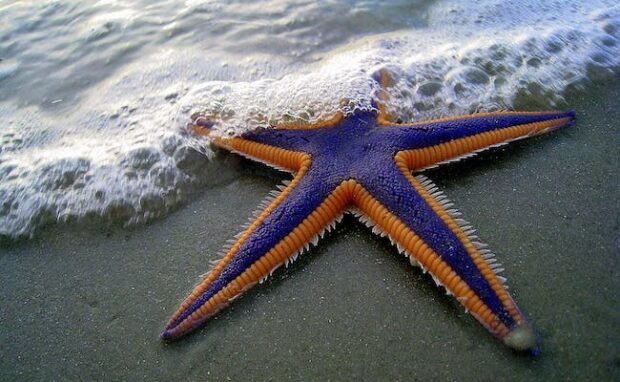Starfish is one giant head, says scientists
Many think a starfish has five tails with a head at the center, but scientists discovered it’s just one giant head. Closer inspection revealed this animal lacks genes that form a torso and tail during its early development. As a result, starfishes somehow found a way to continue living for thousands of years as heads swimming in the ocean.
Scientists have been studying how life developed in our world, but we still have so much to discover. The same goes for the humble starfish, which turned out to be hiding an astounding evolution. Fortunately, these studies have practical purposes beyond mere discovery. Scientists believe it could lead to solving biomedical and ecological problems.
This article will discuss how scientists realized starfish consist of giant heads. Also, I will explain why these experts are so curious about this unique creature.
How did they find this starfish discovery?

A starfish is made up of five arms that it uses to move along the seabed. It doesn’t have a conventional torso, tail, or head seen in other animals.
That is why it has perplexed scientists for centuries. Where is the starfish’s head? Recently, Laurent Formery, a postdoctoral scholar from the University of California and Stanford University, and his team figured out the answer.
As mentioned, they discovered it’s just one massive head. “It’s as if the sea star is completely missing a trunk and is best described as just a head crawling along the seafloor,” said Formery.
“So we ignored the anatomy and asked: Is there a molecular axis hidden under all this weird anatomy? What is its role in a starfish forming a pentaradial body plan?”
CNN said starfish had genetic signatures related to the development of a head. However, they lacked ones for growing torsos and tails. Consequently, sea stars “have the most dramatic example of decoupling of the head and the trunk regions that we are aware of today,” Formery explained.
You may also like: AI system helps create climate-resilient crops
Most animals develop from embryos that eventually divide themselves into a head, torso, and tail. However, sea star larvae transition from two-section bodies to five-section ones.
“This has been a zoological mystery for centuries,” said senior study coauthor Christopher Lowe. “How can you go from a bilateral body plan to a pentaradial plan, and how can you compare any part of the starfish to our own body plan?”
Dr. Jeff Thompson, another coauthor, stated, “In their bilateral relatives, the body is divided into a head, trunk, and tail. But just looking at a starfish, it’s impossible to see how these sections relate to the bodies of bilateral animals.”
How did they find this starfish discovery?
Formery’s team used micro-computed tomography scanning to capture a 3D perspective of a starfish’s shape and structure. The Chan Zuckerberg Biohub funded their research, which launched in 2016.
“If you strip away the skin of an animal and look at the genes involved in defining a head from a tail, the same genes code for these body regions across all groups of animals,” Lowe said.
“So we ignored the anatomy and asked: Is there a molecular axis hidden under all this weird anatomy? What is its role in a starfish forming a pentaradial body plan?”
“When we compared the expression of genes in a starfish to other groups of animals, like vertebrates, it appeared that a crucial part of the body plan was missing,” Thompson said.
You may also like: Coffee consumption might be linked to genes
“The genes that are typically involved in the patterning of the trunk of the animal weren’t expressed in the ectoderm. It seems the whole echinoderm body plan is roughly equivalent to the head in other groups of animals.”
In other words, starfish somehow lost their bodies and became giant underwater heads. “Our research tells us the echinoderm body plan evolved in a more complex way than previously thought, and there is still much to learn about these intriguing creatures,” Thompson said.
Daniel Rokhsar, a Chan Zuckerberg Biohub researcher, stated, “If we take the opportunity to explore unusual animals that are operating in unusual ways, that means we are broadening our perspective of biology, which is eventually going to help us solve both ecological and biomedical problems.”
Conclusion
Scientists discovered starfish have evolved to become mobile marine heads. They somehow lost their torsos and heads from thousands of years ago.
Consequently, scientists want to understand how and why a creature would evolve this way. Moreover, they believe it could help us learn more about life’s origins.
This discovery might also help us create unprecedented medical and ecological solutions. Learn more about the study on the Nature website. Also, check out more digital tips and trends at Inquirer Tech.